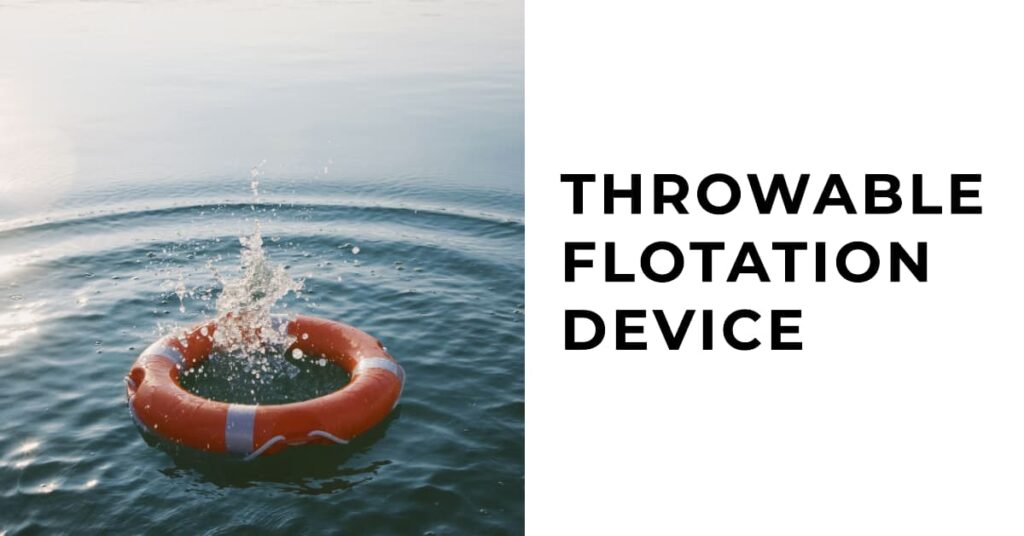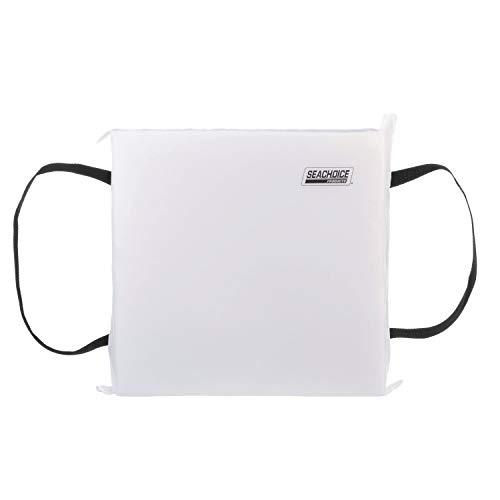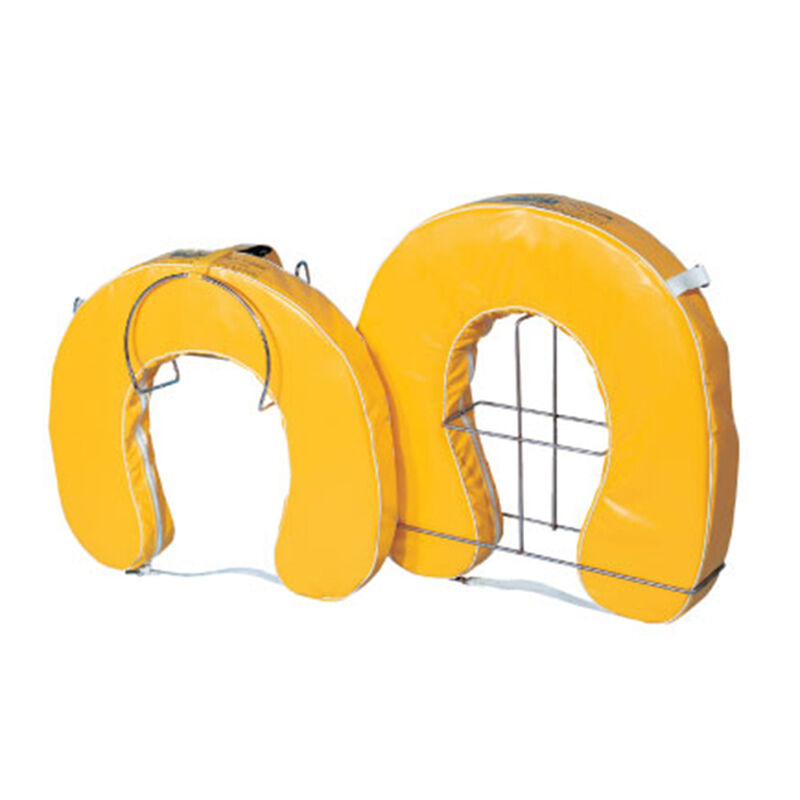A throwable flotation device is a type of life-saving equipment that can be thrown to a person who is in water and struggling to stay afloat. These devices are designed to be lightweight and easy to throw, making them a valuable tool for anyone who spends time near bodies of water.
Throwable flotation devices are commonly used by lifeguards, boaters, and other outdoor enthusiasts and have a number of important advantages and benefits. One of the primary benefits of a throwable flotation device is that it provides an extra layer of safety for people who are in or near the water.
In the event of an emergency, a person can quickly grab the device and throw it to someone who is struggling to stay afloat. This can be especially important in situations where the person in distress is too far away to reach quickly or where the water is too rough for a rescue swimmer to safely approach.
Another benefit of throwable flotation devices is that they are relatively inexpensive and easy to use. Most devices are made from durable materials that can withstand exposure to water and the elements, and they can be stored in a variety of locations, such as on a boat or near a pool.
Additionally, many devices are designed to be brightly colored and highly visible, making them easy to spot in an emergency.

Understanding Throwable Flotation Devices
A throwable flotation device (TFD) is a type of personal flotation device (PFD) that is designed to be thrown to someone in the water in an emergency situation. They are also known as throwable personal flotation devices (PFDs), throwable PFD’s, throwable floatation devices, or throwrafts.
TFDs are typically made of foam or other buoyant materials and are designed to be easily thrown to someone in the water. They can be used in a variety of situations, including boating accidents, swimming pool emergencies, and other water-related emergencies.
One of the benefits of TFDs is that they are easy to use. They require no special training or knowledge to use, and they can be thrown to someone in the water from a safe distance. TFDs are also relatively inexpensive and can be purchased at most sporting goods stores.
When selecting a TFD, it is important to choose one that is appropriate for the intended use. Some TFDs are designed for use in calm waters, while others are designed for use in rough waters. It is also important to choose a TFD that is appropriate for the weight of the person who will be using it.
In conclusion, TFDs are an important safety device that can be used in a variety of water-related emergencies. They are easy to use, relatively inexpensive, and can be purchased at most sporting goods stores. When selecting a TFD, it is important to choose one that is appropriate for the intended use and the weight of the person who will be using it.
Types of Throwable Flotation Devices
Throwable flotation devices, also known as Type IV devices, are designed to be thrown to a person in the water to provide buoyancy and keep them afloat. There are different types of throwable flotation devices available, each with its own unique features and benefits.
Horseshoe Buoy
The horseshoe buoy is a traditional Type IV throwable flotation device that is commonly used on boats. It is designed to be thrown to a person in the water and has a horseshoe shape that fits around the neck to provide support and keep the person’s head above water.
Horseshoe buoys are typically made of foam or inflatable materials and are available in different sizes and colors. Here are two examples available on Amazon and West Marine:

Ring Buoy
The ring buoy is another popular Type IV throwable flotation device that is commonly used on boats and around pools. It is designed to be thrown to a person in the water and has a circular shape that provides support and keeps the person’s head above water.
Ring buoys are typically made of foam or inflatable materials and are available in different sizes and colors.
West Marine offer ring buoys in various designs, here is one of the ring buoy available on Amazon for illustration.

Flotation Cushion
The flotation cushion is a Type IV throwable flotation device that is designed to be used as a seat cushion on boats and can also be thrown to a person in the water.
It is made of foam or inflatable materials and provides buoyancy and support to keep the person afloat. Flotation cushions are available in different sizes and colors.

Overall, it is important to choose the right Type IV throwable flotation device for your needs. Consider factors such as the type of water activities you will be participating in and the size and weight of the device. Always make sure to follow the manufacturer’s instructions for proper use and maintenance of your throwable flotation device.
Regulations and Standards
When it comes to throwable flotation devices, there are regulations and standards that must be followed to ensure safety. The United States Coast Guard (USCG) is the governing body responsible for setting these regulations and standards.
According to USCG regulations, all recreational boats must have at least one throwable flotation device on board. This device must be USCG approved and readily accessible. Additionally, the device must be immediately available for use in case of an emergency.
The USCG has specific requirements for the design and construction of throwable flotation devices. These requirements ensure that the devices are effective and reliable in an emergency situation. USCG approved devices are rigorously tested to meet these requirements.
It is important to note that not all throwable flotation devices are USCG approved. Using a non-approved device can result in fines or penalties. It is always recommended to check the label of the device to ensure that it is USCG approved.
In addition to USCG regulations, there may be state or local laws that apply to the use of throwable flotation devices. It is important to check with the appropriate authorities to ensure compliance with all applicable regulations and standards.
Overall, following USCG regulations and using USCG approved throwable flotation devices is essential for ensuring safety on the water. By doing so, boaters can be confident in their preparedness for emergency situations.
Usage and Care of Throwable Flotation Devices
Throwable flotation devices are an important safety tool for anyone who spends time on or near the water. These devices can help save lives in the event of an emergency, but it’s important to use and care for them properly to ensure their effectiveness. Here are some tips for using and caring for throwable flotation devices:
Usage:
- Always have a throwable flotation device on hand when boating or participating in water activities.
- Make sure the device is easily accessible and visible in case of an emergency.
- Know how to use the device properly before you need to use it.
- When throwing the device, aim for the person in the water and try to get it as close as possible to them.
- Do not throw the device directly at the person in the water, as it could injure them.
- Once the person has grabbed onto the device, slowly and carefully pull them to safety.
Care:
- Store the device in a dry, cool place when not in use.
- Inspect the device regularly for any signs of damage or wear.
- Replace the device if it is damaged or shows signs of wear.
- Follow the manufacturer’s instructions for cleaning and maintenance.
- Do not use the device as a toy or for any purpose other than its intended use.
- If the device is inflatable, make sure to properly inflate it before use and check the inflation regularly.
By following these usage and care tips, you can help ensure that your throwable flotation device is ready to use in case of an emergency. Remember to always put safety first when enjoying water activities.
Selecting the Right Throwable Flotation Device
When it comes to boating safety, having a throwable flotation device on board is essential. But with so many options available, it can be challenging to know which one to choose. Here are some factors to consider when selecting the right throwable flotation device for your needs.
Type of Boat: The type of boat you have will determine the type of throwable flotation device you need. For example, a kayak or canoe will require a smaller device than a larger boat.
Water Activities: Consider the water activities you will be participating in when selecting a throwable flotation device. If you plan on fishing, a cushion-style device may be more comfortable to sit on. If you will be participating in water sports, a foam or bulkhead device may be more appropriate.
Boating Safety Regulations: It’s important to check the boating safety regulations in your area to ensure you are selecting a throwable flotation device that meets the requirements. For example, some states require a Type V device for personal watercraft.
Manufacturer: Look for a reputable manufacturer when selecting a throwable flotation device. Mustang Survival and Stearns are two well-known manufacturers of boating safety gear in the USA.
New vs. Used: While purchasing a new throwable flotation device is always recommended, it’s important to ensure that any used device is still in good condition and meets safety regulations.
Mounting Options: Consider how you will mount the device on your boat. Rail mount options are available for larger boats, while smaller boats may require a device that can be easily stored.
Material: Look for a device made from durable materials such as vinyl to ensure it will last for years to come.
By considering these factors, you can confidently select the right throwable flotation device for your boating needs.
Top Manufacturers and Products
When it comes to throwable flotation devices, there are several manufacturers and products to choose from. Here are some of the top options on the market:
Jim Buoy
Jim Buoy is a well-known manufacturer of marine safety equipment, including throwable flotation devices. Their products are designed to be durable and reliable, and they offer a range of options to suit different needs. Some of their most popular products include:
- Jim Buoy Model 750: This is a horseshoe-shaped buoy that is designed to be thrown to a person in distress. It is made from durable vinyl and features a high-visibility orange color for easy spotting in the water.
- Jim Buoy Model 800: This is a ring buoy that is also designed to be thrown to a person in distress. It features a molded-in rope holder and a reflective tape for increased visibility in low-light conditions.
The Survivor
The Survivor is a brand that specializes in personal safety life rafts and other survival gear. They offer several options for throwable flotation devices, including:
- The Survivor Life Raft: This is a compact, lightweight life raft that can be deployed quickly in an emergency. It features a bright orange color for easy spotting and is designed to keep people afloat in the water until rescue arrives.
- The Survivor Life Ring: This is a traditional ring buoy that is designed to be thrown to a person in distress. It features a high-visibility orange color and a reflective tape for increased visibility.
West Marine
West Marine is a popular retailer of boating and marine supplies, including throwable flotation devices. They offer a wide range of products from various manufacturers, including:
- Stearns Flotation Cushion: This is a cushion-style flotation device that is designed to be thrown to a person in distress. It features a durable nylon shell and a webbing strap for easy carrying.
- Orion Coastal Alert/Locate Signal Kit: This is a kit that includes a signal whistle and a signal mirror, as well as a floating storage case. It is designed to help people attract attention and signal for help in an emergency.
Other Options
There are several other manufacturers and products worth considering, including:
- Lifesling: This is a unique product that combines a hoistable sling with a flotation device. It is designed to help people rescue someone who has fallen overboard.
- Safety Gear: This is a brand that offers a range of marine safety equipment, including throwable flotation devices. Some of their products include ring buoys, horseshoe buoys, and cushions.
- COM: This is a manufacturer of inflatable life rafts and other safety equipment. While they do not offer traditional throwable flotation devices, their products can be a good option for those who need a more comprehensive safety solution.
Overall, there are plenty of options when it comes to choosing a throwable flotation device. It’s important to consider factors like durability, visibility, and ease of use when making a decision.
Boating and Water Sports
When it comes to boating and water sports, safety should always be a top priority. One essential safety tool that should be on board every boat is a throwable flotation device. These devices are designed to be thrown to a person in the water who is in distress, providing them with a means of staying afloat until help arrives.
Throwable flotation devices come in a variety of shapes and sizes, including ring buoys, horseshoe buoys, and throwable cushions. They are typically made of durable materials such as foam or plastic, and are brightly colored for easy visibility.
In addition to being required by law on most boats, throwable flotation devices can also be a lifesaver in emergency situations. Whether you’re out on a calm lake or navigating rough waters, having a throwable flotation device on board can provide peace of mind and potentially save lives.
When selecting a throwable flotation device, it’s important to ensure that it meets the U.S. Coast Guard’s requirements for size, shape, and buoyancy. It should also be easily accessible in case of an emergency.
Overall, a throwable flotation device is an essential safety tool for any boater or water sports enthusiast. By choosing the right device and keeping it on board at all times, you can help ensure a safe and enjoyable experience on the water.
Frequently Asked Questions
What are the requirements for a Type IV throwable device?
A Type IV throwable device must be Coast Guard approved and must be able to be thrown to a person in the water. It must also be able to float and must have a minimum buoyancy of 16.5 pounds.
Which boats are required to carry a Type IV throwable device?
All boats that are 16 feet or longer, except for canoes and kayaks, are required to carry a Type IV throwable device. In addition, boats that are less than 16 feet long must carry a throwable device if they are not designed to be self-bailing.
How do you properly use a Type IV throwable device?
To use a Type IV throwable device, you should hold onto the straps or handles and throw it to the person in the water. It is important to aim for the person’s head and to make sure that the device lands within their reach. The person in the water should then hold onto the device until they can be rescued.
Is a throwable PFD considered Coast Guard approved?
Yes, a throwable PFD is considered Coast Guard approved as long as it meets the requirements for a Type IV throwable device.
What are the best options for a Type IV throwable device?
The best options for a Type IV throwable device include horseshoe buoys, ring buoys, and buoyant cushions. It is important to choose a device that is easy to throw and that will float for an extended period of time.
What is the cost of a Type IV throwable device?
The cost of a Type IV throwable device can vary depending on the type and brand. On average, they can range from $20 to $100. It is important to choose a device that is durable and reliable, even if it means spending a little more money.
- Types of Gas Carriers as per IGC Code – April 22, 2025
- Wind-Assisted Propulsion Systems (WAPS): A Game Changer for Maritime Decarbonization – February 6, 2025
- 10 Boat Salvage Yards in California – January 25, 2025




